In case you want to emphazise small values in your data in an image plot, I would never change the actual data itself. That can lead to a lot of confusion.
Instead, as I said in the comments, change the colormap.
Ways of doing so are documented in the Matplotlib Color Normalization Tutorial as well as here on SO. Especially this article and the answers within are really illustrative of the possibilities one has.
I combined two concepts in the example below to show the options.
- One is to rescale the colormap such that the value that initially was at the middle (
midpoint) of your colormap is shifted down. In this way more variation is added between 0 and the new midpoint, while everything above is stretched. One can think of this as two linear colormaps spliced together.
- The other is to simply use a logarithmic scaling of the colors.
This is the example code
import numpy as np
import matplotlib
import matplotlib.pyplot as plt
import matplotlib.colors as colors
def shiftedColorMap(cmap, start=0, midpoint=0.5, stop=1.0, name='shiftedcmap'):
'''
function taken from
https://stackoverflow.com/questions/7404116/...
...defining-the-midpoint-of-a-colormap-in-matplotlib
Function to offset the "center" of a colormap. Useful for
data with a negative min and positive max and you want the
middle of the colormap's dynamic range to be at zero
Input
-----
cmap : The matplotlib colormap to be altered
start : Offset from lowest point in the colormap's range.
Defaults to 0.0 (no lower ofset). Should be between
0.0 and `midpoint`.
midpoint : The new center of the colormap. Defaults to
0.5 (no shift). Should be between 0.0 and 1.0. In
general, this should be 1 - vmax/(vmax + abs(vmin))
For example if your data range from -15.0 to +5.0 and
you want the center of the colormap at 0.0, `midpoint`
should be set to 1 - 5/(5 + 15)) or 0.75
stop : Offset from highets point in the colormap's range.
Defaults to 1.0 (no upper ofset). Should be between
`midpoint` and 1.0.
'''
cdict = { 'red': [], 'green': [], 'blue': [], 'alpha': [] }
# regular index to compute the colors
reg_index = np.linspace(start, stop, 257)
# shifted index to match the data
shift_index = np.hstack([
np.linspace(0.0, midpoint, 128, endpoint=False),
np.linspace(midpoint, 1.0, 129, endpoint=True)
])
for ri, si in zip(reg_index, shift_index):
r, g, b, a = cmap(ri)
cdict['red'].append((si, r, r))
cdict['green'].append((si, g, g))
cdict['blue'].append((si, b, b))
cdict['alpha'].append((si, a, a))
newcmap = matplotlib.colors.LinearSegmentedColormap(name, cdict)
plt.register_cmap(cmap=newcmap)
return newcmap
x = np.linspace(-3, 3, num=601)
X,Y = np.meshgrid(x,x)
Z = np.sinc( (X*np.cos(1)+Y*np.sin(1))**2 +(-X*np.sin(1)+0.2*Y*np.cos(1))**2 )**2
orig_cmap = matplotlib.cm.viridis
shifted_cmap = shiftedColorMap(orig_cmap, midpoint=0.05, name='shifted')
fig = plt.figure(figsize=(4,9))
ax = [fig.add_subplot(3,1,n+1) for n in range(3)]
# normal cmap
im0 = ax[0].imshow(Z, interpolation="none", cmap=orig_cmap)
fig.colorbar(im0, ax=ax[0])
ax[0].set_title('Default behavior (hard to see small values)', fontsize=10)
#example using the custom shiftedColorMap function
#taken from https://stackoverflow.com/questions/7404116/defining-the-midpoint-of-a-colormap-in-matplotlib
im1 = ax[1].imshow(Z, interpolation="none", cmap=shifted_cmap)
fig.colorbar(im1, ax=ax[1])
ax[1].set_title('Center of colormap shifted to 0.05', fontsize=10)
#example using colors.LogNorm()
#taken from http://matplotlib.org/users/colormapnorms.html
im2 = ax[2].imshow(Z, interpolation="none", norm=colors.LogNorm(vmin=10e-5, vmax=Z.max()), cmap=orig_cmap)
fig.colorbar(im2, ax=ax[2])
ax[2].set_title('Logarithmically scaled Colormap', fontsize=10)
for axis in ax:
axis.set_yticks([])
axis.set_xticks([])
plt.tight_layout()
plt.show()
producing

